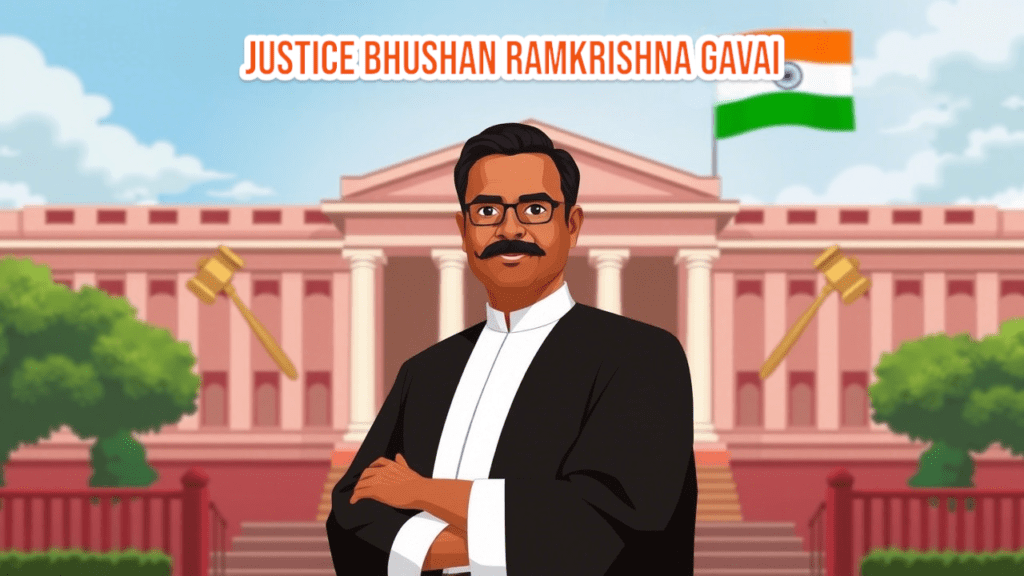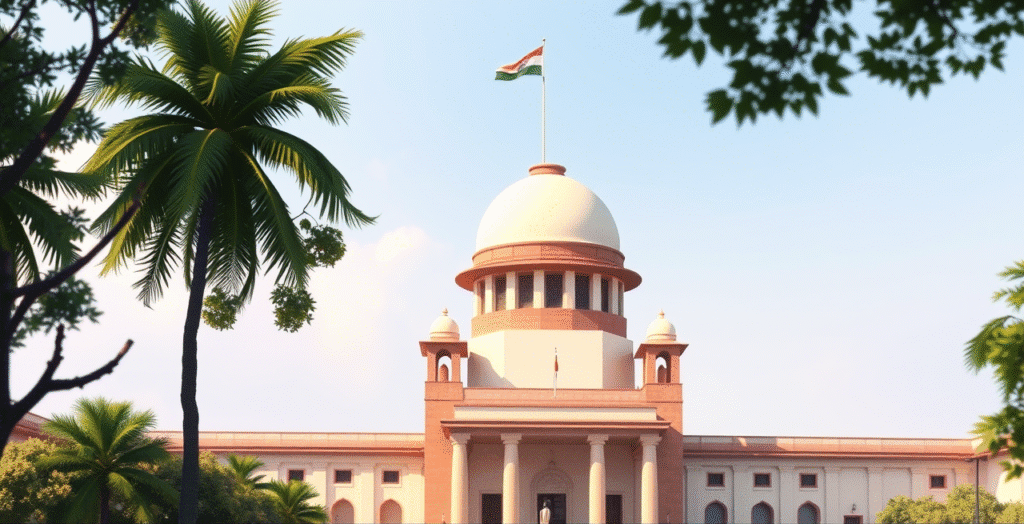
Justice Bhushan Ramkrishna Gavai is set to become the 52nd Chief Justice of India, succeeding the current Chief Justice, Sanjiv Khanna, whose tenure will conclude on May 13 next month. Justice Gavai has been recommended by Chief Justice Sanjiv Khanna to the central government for appointment as the next Chief Justice of India, in accordance with the tradition of appointing the senior-most judge of the Supreme Court to the position. Justice Bhushan Ramkrishna Gavai’s tenure as Chief Justice of India is expected to last over six months, concluding on November 23.
Table of Contents
Static Knowledge of the Supreme Court of India
- First Chief Justice of India : Harilal J. Kania
- First Chief Justice of the Supreme Court of Judicature at Fort William in Bengal : Sir Elijah Impey
- 51st Chief Justice of India : Sanjiv Khanna
- Supreme Court of India Inaugurated : January 28, 1950
- Articles Related to Judiciary : Articles 124 to 147 of the Indian Constitution
- Total Judges in the Supreme Court : 34, including the Chief Justice
The original strength of the Supreme Court was fixed at eight judges—one Chief Justice and seven other judges. Over the years, the sanctioned strength has been increased multiple times: to 10 in 1956, 13 in 1960, 17 in 1977, 25 in 1986, 30 in 2008, and finally to 33 in 2019.
Stay updated with current affairs and explore new job opportunities – click here.
Appointment of the Chief Justice of India

From 1950 to 1973, the tradition was to appoint the senior-most judge of the Supreme Court as the Chief Justice of India. However, this convention was disrupted in 1973 when Justice A.N. Ray was appointed as the Chief Justice by superseding three senior judges—J.M. Shelat, K.S. Hegde, and A.N. Grover. These three judges resigned from the Supreme Court in protest, citing the government’s dissatisfaction with their judgment in the Kesavananda Bharati case (1973), which had not favored the government’s position.
Similarly, in 1977, Justice M.U. Beg was appointed as the Chief Justice of India, superseding the then senior-most judge, Justice H.R. Khanna. This decision was influenced by Justice Khanna’s landmark judgment upholding the right to life even during an emergency in the ADM Jabalpur v. Shivkant Shukla case (1976). Justice Khanna’s dissenting opinion in this case became a defining moment in Indian judicial history.
The appointment of Justice Bhushan Ramkrishna Gavai as the next Chief Justice of India reaffirms the principle of seniority in judicial appointments, ensuring continuity and stability in the functioning of the judiciary. His tenure is expected to uphold the values of justice, fairness, and constitutional integrity that are the cornerstones of India’s legal system.
As the 52nd Chief Justice of India, Justice Gavai will play a pivotal role in shaping the judiciary’s response to contemporary challenges while safeguarding the principles enshrined in the Constitution. His leadership will undoubtedly leave a lasting impact on India’s legal landscape.
Qualifications for Judges of the Supreme Court
To be appointed as a Judge of the Supreme Court, a person must meet the following qualifications:
- He/she should be a citizen of India.
- He/she should have been a judge of a High Court for at least five years.
- He/she should have been an advocate of a High Court for at least ten years.
- He/she should be a distinguished jurist in the opinion of the President of India.
Notably, there is no minimum age requirement specified for the appointment of a judge of the Supreme Court. However, a judge can hold office until the age of 65 years, after which they must retire.
To explore more about the rich history and culture of Punjab, please click here.
Oath or Affirmation
Before assuming office, every Judge of the Supreme Court, including the Chief Justice, must take an oath or affirmation before the President of India or another person authorized by the President. The oath includes a pledge to uphold the Constitution of India and perform duties without fear, favor, affection, or ill-will.
Salaries and Allowances
In 2018, the salary of the Chief Justice of India was increased to ₹2.8 lakh per month from ₹1 lakh per month, while the salary of other judges was raised to ₹2.5 lakh per month from ₹90,000. After retirement, the Chief Justice and other judges are entitled to receive 50% of their last-drawn salary as a monthly pension. In addition to their salaries, judges are provided with various allowances and facilities, including sumptuary allowance, free accommodation, medical benefits, car facilities, and telephone services.
Historical Facts about Salaries
The salaries of Supreme Court judges have undergone several revisions since the inception of the court:
- In 1950, the Chief Justice’s salary was ₹5,000 per month, while other judges received ₹4,000 per month.
- In 1986, these were revised to ₹10,000 and ₹9,000 per month, respectively.
- In 1998, the salaries were further increased to ₹33,000 for the Chief Justice and ₹30,000 for other judges.
- In 2009, the salaries were hiked to ₹1 lakh for the Chief Justice and ₹90,000 for other judges.
These periodic revisions reflect the government’s commitment to ensuring that the judiciary remains adequately compensated and independent.
Advocates Authorized to Practice Before the Supreme Court
The Supreme Court of India recognizes three categories of advocates who are authorized to practice law before it:
- Senior Advocates
Senior Advocates are designated as such by the Supreme Court or any High Court based on their expertise, experience, and standing in the legal profession. However, they are not entitled to appear independently in the Supreme Court. They must always appear alongside an Advocate-on-Record or a junior advocate in any court or tribunal in India. This ensures that their specialized knowledge complements the procedural expertise of other advocates. - Advocates-on-Record
Only Advocates-on-Record are authorized to file any matter or document before the Supreme Court. They play a crucial role in the functioning of the court as they can also file appearances and act on behalf of parties in cases. Their designation requires them to pass a rigorous examination conducted by the Supreme Court and adhere to strict professional standards. - Other Advocates
These advocates are registered with any State Bar Council and can appear and argue cases on behalf of parties in the Supreme Court. However, they cannot file documents or matters directly before the court. Their participation is limited to advocacy and oral arguments, ensuring that only Advocates-on-Record handle procedural and filing responsibilities.
For complete details on Punjabi grammar rules, please click here
This structured categorization of advocates ensures the efficient administration of justice while maintaining high professional standards in the Supreme Court.
In conclusion, Justice Bhushan Ramkrishna Gavai’s appointment as the 52nd Chief Justice of India marks a significant milestone in the country’s judicial history. With his extensive experience and adherence to constitutional principles, he is poised to lead the judiciary through a transformative phase. Alongside his qualifications, the provisions related to oaths, salaries, and allowances underscore the importance of maintaining the independence and dignity of the judiciary in India.
